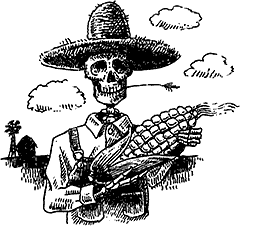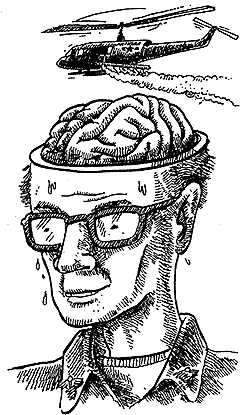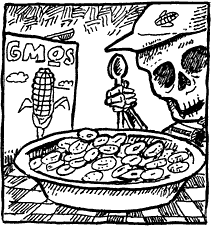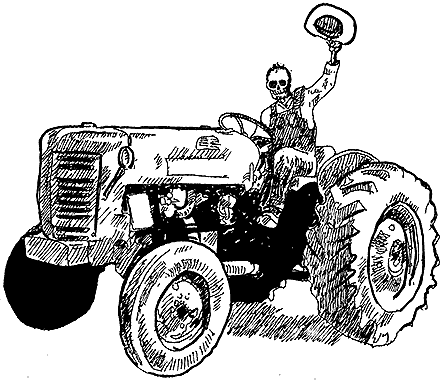 |
||||||||||||
|
November/December 2014
BY LOANA HOYLMAN A helluva fight is brewing over genetically modified organisms. Basically, the GMO story goes like this: People have been genetically modifying food since agriculture began thousands of years ago. But that is through cross-breeding for a hardier tomato or a sweeter apple. GMOs, on the other hand, were first generated in 1994, only twenty years ago. The process involves injecting food crops and animals with pesticides, viruses, bacteria, and DNA from other species to allow such plants and animals to resist pests or enhance qualities, such as large breasts in poultry. Vietnam Veterans of America and Children of Vietnam Veterans Health Alliance (COVVHA) have strong reservations about GMOs. Many children and grandchildren of veterans returning from the war in Vietnam were adversely affected by Agent Orange/dioxin that their fathers and mothers were exposed to. Some of the ingredients in Agent Orange and other poisons are present in GMOs.
Six large corporations are involved in GMO production: Monsanto, Dow, DuPont, BASF, Bayer, and Syngenta. They are the kings of the agricultural market: They create the seeds, grow the GMO crops, and manufacture the pesticides. Vietnam veterans have extraordinarily high rates of lymphoma. After years of fighting for recognition of this fact, the Department of Veterans Affairs finally acknowledged direct links between exposure to Agent Orange and serious illnesses. But it doesn’t end there. The effects of Agent Orange have been passed on to the progeny of Vietnam veterans. COVVHA was founded by Kelly Derricks and Heather Bowser, daughters of Vietnam vets. Both women are disabled, as are many offspring of Vietnam veterans, through the third generation. They have fallen ill with spinal problems (most commonly spina bifida), endocrine problems, infertility, birth defects, musculoskeletal issues, autoimmune diseases, and neurological dysfunction. Any one of these can be fatal. The list grows every year. VVA and COVVHA oppose GMOs because the pesticides they carry are as poisonous as Agent Orange. In a recent letter to President Obama, VVA asked for delays in approving what veterans call “Agent Orange Corn.” That’s not what DowAgro Sciences is calling it. They named it “Enlist.” VVA’s letter to the President says the name is “a slap in the face to all Vietnam veterans.” An article in The New Yorker this year titled “Seeds of Doubt” noted: “By engineering, patenting, and transforming seeds into costly packets of intellectual property, multinational corporations such as Monsanto, with considerable assistance from the World Bank, the World Trade Organization, the United States government, and even philanthropies like the Bill and Melinda Gates Foundation, are attempting to impose ‘food totalitarianism’ on the world.” Aside from the chemicals in the pesticides of GMOs, there are other, hidden problems. Even if companies labeled food products as containing pesticides, it’s the mix with other—inert— ingredients that can be far more deadly. “Inert” or “inactive” sounds harmless enough. But in a study published by the Journal of Toxicology, these inactive ingredients are defined as “solvents, preservatives, surfactants (detergents, emulsifiers, dispersants), and other substances, none of which are natural to animals or plants.” It is the whole formulation that is toxic, ingredients reacting with each other to create soups from hell. It is not only the plants you eat that are GMOs of unknown qualities. Sprays drift to other plants, both cultivated and wild. No one knows what will become of wild plants contaminated with DNA-altering properties.
One study by DowAgro Sciences says 2,4-D is “practically non-toxic to both freshwater and estuarine/marine fish, amphibians (frogs),” is “practically non-toxic to honey bees and earthworms,” and is “only slightly toxic to aquatic invertebrates.” Practically? Only slightly? Even if the pesticide disappears in a few hours, it takes only seconds for animals to be contaminated. A far more ubiquitous pesticide is glyphosate, found in Monsanto’s Roundup. Last year alone, 90 percent of 500 million GMO acres were soaked with some 2 billion pounds of glyphosate. It’s in food, water, female blood, and fetal blood—both animal and human. It even falls on us in the rain. Glyphosate is accused of drastically increasing gluten intolerance and celiac disease, which have become widespread health problems. The National Library of Medicine and Food and Chemical Toxicology have published several studies showing that glyphosate is an endocrine disruptor that affects every bodily function. It causes DNA damage and neurological dysfunction. Glyphosate disrupts hormone production, possibly leading to abnormal fetal development, low birth weight, and miscarriages. Moreover, Roundup’s glyphosate is a xenoestrogen—a synthetic chemical that mimics estrogen. Although some xenoestrogens are found naturally and are benign, man-made xenoestrogens disrupt hormone cycles and overload reproductive systems. Precocious (early) puberty in both boys and girls, endometriosis, breast cancer, ovarian cancer, infertility, and obesity have been linked to xenoestrogens, and all have been rising at significant rates. Xenoestrogens are in pesticides, as well as in dry-cleaning chemicals, car fumes, plastic, detergent, and hundreds of other everyday products. There are bacteria in our gut that kill pathogens such as botulism, which is on the rise in cattle that are fed GMO grains. Researchers in Germany found that these “good” bacteria in mammals, such as cattle, are extremely vulnerable: Glyphosate kills them. And remember those inert ingredients? A study published by BioMed Research International concluded that “Roundup herbicide is 125 times more toxic than its active ingredient glyphosate studied in isolation.” In other words, testing the meat but none of the vegetables, liquids, or herbs in this toxic soup resulted in grossly underestimating the herbicide’s potency. One group researched nine pesticides to test the active ingredients on three human cell lines. Eight of the nine formulations (soups) were more toxic than the active ingredient alone—as much as a thousand times more toxic. So, if only the active ingredient is tested and not the entire formulation, the test is nearly useless. But if you want to know which inert ingredients are in pesticides, forget it. Federal law says these are trade secrets, even though inert ingredients can make up as much as 99 percent of a given product. Another widely used pesticide in GMOs is called Bt. Bt corn crops are genetically engineered to produce a toxin from the Bacillus thuringiensis bacterium. It is harmful to insects that are not targeted, such as beetles, flies, moths, and butterflies (the disappearing monarchs). All four of these groups are pollinators, without which many plants will disappear. But it isn’t just the spraying of Bt that is dangerous, even though it migrates to air and water, including rain. It’s inside food. The Bt toxin has been found in 93 percent of pregnant women and 80 percent of their babies. Bt has helped create superpests. The European corn borer, for example, is resistant to Bt. In 2009 Monsanto scientists said the pink bollworm in India is resistant to Bt, as it is in Australia, China, Spain, and the United States. In Florida and Puerto Rico, army worms are resistant to Dupont-Dow’s GM corn that is flush with Bt. They’re called superweeds and superpests. Thirteen million acres are infected. Don’t worry, the corporations that make the pesticides have a solution: Use more pesticides, especially ones that are put into the crops themselves. At least 211 species are resistant to these pesticides. GMOs were supposed to end world hunger. But yields of GMO crops have decreased 6 percent. The financial costs have been enormous. Some of the costs are in federal farm subsidies. GMO corn and rapeseed cost taxpayers $12 billion in subsidies in the last fifteen years. The lost export of GMO corn costs close to $300 million a year. Soy exports also have decreased. All in all, we have lost export trade because other countries do not want GMOs—a loss of $3-5 billion. When China rejected GMO corn, the U.S. lost close to $3 billion. The Wall Street Journal reported that corporations that export GMO corn, such as Archer Daniels Midland, lost $225 million.
The corporations that produce GMOs have an answer. Their plan is to douse plants with even more pesticides. Because many of the pests that pesticides were supposed to eliminate have become stronger than ever, farmers and households are being sold ever more toxic poisons to kill the superweeds and superpests. By 2006, glyphosate use was at 96.7 million pounds. In 2007, 185 million pounds of glyphosate were used on crops in the U.S. An additional 5-8 million pounds were used in houses and gardens. Government, industries, and commerce used 13-15 million pounds. Between 1996 and 2008 U.S. farmers sprayed an extra 383 million pounds of herbicide on GMOs. The USDA has deregulated new GMO corn and soy seeds that will stand up to 2,4-D. But an impact study predicts a 200-600 percent increase in 2,4-D use. An example of new pesticide/crop formulations is a soybean produced by Monsanto using dicamba, a kissing cousin to 2,4-D. In addition, Roundup Ready genes will be included in the bean. And the new bean is supposed to be sprayed with Monsanto’s new dicamba-glyphosate pesticide. It will hit the market in 2015, if approved. Who approves this stuff? Several former employees of GMO corporations are now in government positions of power regarding GMOs. Roger Beachy is director of the USDA National Institute of Food and Agriculture. He used to be the director of Monsanto’s Danforth Plant Science Center. Ramona Romero, the general counsel for the Department of Agriculture, was the principal legal advisor to USDA Secretary Tom Vilsack. The former governor of Iowa, Vilsack was named Governor of the Year by the Biotechnology Industry Organization, an industry lobbying group. Islam Siddiqui is the former chief agricultural negotiator in the Office of the U.S. Trade Representative, a powerful position that advises the White House about international trade negotiations related to agricultural products. Siddiqui was a registered lobbyist for CropLife America, which represents the big GMO-producing companies. The problem is even deeper than that. Monsanto’s position is that the safety of GMOs is not their problem. It’s the FDA’s problem. Their mission is to sell. The White House loves biotechnology and has urged the FDA to implement policies to promote it. So who is in charge? Why, the former vice president of Monsanto, Michael Taylor. He’s our food safety czar.
However, some limited—if coded—information is available. It’s contained on the tiny labels on produce, coded in a series of numbers. The first number indicates how the produce is grown. If the series begins with 4, it is conventionally grown. If it begins with 9, it is organically grown. Some numbers begin with 3, but no one seems to know what this means. The code for GMOs is supposed to be 8, but no one has ever used it. Unless food is organic, there is no way to tell what is GMO and what is not. The corporations producing GMOs are not required to inform the USDA, the EPA, or any other government agency about what is in their GMOs, when they are produced, or where they are produced. So, what happens if GMO seeds are dispersed by wind and then land in your organic field? First, you lose your organic standing. Then you lose your seeds because they are contaminated. You lose organic crops, maybe forever, because there is no getting rid of GMO contamination. Then Monsanto, which owns the GMO seeds, sues you. Yep, they sue you because you are using their patented seeds without permission. There have been more than 145 lawsuits brought by Monsanto since 1997. DuPont also polices its GMO seed drift. The company hires retired police officers to find farmers who are “improperly using” DuPont’s GMO seed. This is happening all over the world. Monsanto and the other GMO producers always win. They also win the appeals. GMO seed dispersal is not the only problem. Lying about poison is another. Monsanto gave the EPA false research and hid information about dioxin and Agent Orange. In the 1960s, Monsanto knew that dioxin caused kidney and liver damage and chloracne. Monsanto memos from the 1970s show that the company sent falsified herbicide samples to USDA. They left some things out and neglected to send highly contaminated samples. This fraud did not end with Agent Orange exposure in Vietnam. At the Monsanto plant in Nitro, West Virginia, many workers became very sick. Some died. EPA began investigating but quickly dropped the case. Monsanto claimed that dioxin, ubiquitous in the factory and the town, did nothing but create chloracne, a terrible skin condition. For years Monsanto declared that if chloracne was not present, then there was no contamination. In other words, if you had non-Hodgkin’s lymphoma but no chloracne, your cancer must have come from somewhere else. Raymond Suskind of the University of Cincinnati was hired by Monsanto to study the workers. His public report repeated the chloracne myth. But his private report revealed that the only people he studied were those with chloracne, not those who had lymphoma and other possibly fatal diseases. Those he ignored. It was Agent Orange reporting all over again. The National Institute of Occupational Safety and Health made a study of the same Nitro incident. It found a substantial increase in cancers in the workers at Monsanto, not just in Nitro. In the end, Monsanto had to pay $93 million in a class-action lawsuit brought by the people in Nitro. But nothing has changed. In 2005 the USDA approved a new alfalfa filled with pesticides. So many groups complained that the USDA reversed its decision, citing agricultural, ecological, and economic dangers. But it took only a month for the USDA to backtrack, again, and approve this alfalfa. GMOs invented by large corporations have been around for a very short time. Whether GMOs are beneficial to humankind or harmful, the public has no say in whether people will ingest these foods. Even the FDA does not require knowledge of the presence of GMOs in our food and environment. They give the corporations a free pass while ignoring the demands of the American public, who overwhelmingly want GMO foods labeled. It is the same pass that was given to Agent Orange.
|
||||||||||||
|
|
||||||||||||
|
||||||||||||
8719 Colesville Road, Suite 100, Silver Spring. MD 20910 | www.vva.org | contact us |
||||||||||||










 There are many reports claiming GMOs are safe. These reports are typically issued by the companies themselves—the same companies that created PCBs, DDT, and Agent Orange. These, too, they said, were safe.
There are many reports claiming GMOs are safe. These reports are typically issued by the companies themselves—the same companies that created PCBs, DDT, and Agent Orange. These, too, they said, were safe.  One ingredient in GMOs is 2,4-D, a main component of Agent Orange. Despite denials by Dow, 2,4-D contains dioxin. Farm workers in California using 2,4-D came down with stomach cancer in alarming numbers. Farmers in Nebraska have high rates of lymphoma. Across the world, the number of illnesses is disquieting. But 2,4-D isn’t only affecting those who use the sprays. Exposure can occur in many ways. Sprays drift in the air and settle on water. Children, pregnant women, dogs, and cats are particularly susceptible.
One ingredient in GMOs is 2,4-D, a main component of Agent Orange. Despite denials by Dow, 2,4-D contains dioxin. Farm workers in California using 2,4-D came down with stomach cancer in alarming numbers. Farmers in Nebraska have high rates of lymphoma. Across the world, the number of illnesses is disquieting. But 2,4-D isn’t only affecting those who use the sprays. Exposure can occur in many ways. Sprays drift in the air and settle on water. Children, pregnant women, dogs, and cats are particularly susceptible. The vast majority of the American people (more than 91 percent) want GMO foods labeled. The government and the GMO companies don’t. They say people don’t understand GMOs and will be afraid to buy them.
The vast majority of the American people (more than 91 percent) want GMO foods labeled. The government and the GMO companies don’t. They say people don’t understand GMOs and will be afraid to buy them.